Kemi is a writer & creative consultant. She is the founder of DADDY, a Berlin-based culture magazine and consultancy with a focus on diversifying the media landscape.
Don't wanna be here? Send us removal request.
Photo

South-North Conversations | Decolonising Sustainability Journalism
South–North Conversations examines the impact of fast fashion and waste colonialism, focusing on the unequal representation of African countries in sustainability journalism.
The project aims to challenge dominant Western narratives and elevate the voices of experts from the Global South, addressing the colonial biases often found in reporting.


Sustainability in Focus – A Decolonial Approach to Journalism
South–North Conversations explores fast fashion, waste colonialism, and the challenges of achieving fair reporting, particularly in African countries. Initiated by Kemi Fatoba, freelance journalist and founder of DADDY, a magazine for underrepresented perspectives in the media, she advocates for the decolonisation of sustainability journalism.
While sustainability journalism plays a crucial role in shaping our understanding of environmental and social issues, colonial patterns of thought are frequently reproduced, especially in coverage of the Global South. Western narratives often dominate, leaving the perspectives of the Global South marginalised. The goal of “South–North Conversations” is to address these inequalities and amplify the voices of experts from the Global South and North.
The research involved contributions from a range of experts, including Aja Barber, Chiponda Chimbelu (DW), Beatrace Angut Oola (Fashion Africa Now), Erica de Greef (African Fashion Research Institute), Monica Titton and Pumla Maswanganyi. These key figures provided insights into how media portrays fast fashion and waste issues and offered perspectives on sustainable solutions coming from the Global South.


Findings and Challenges
Fast Fashion relies on fast, cheap production, with clothes discarded after minimal use. A large amount of this waste ends up in the Global South, particularly in African countries that lack the infrastructure to deal with such vast amounts of textile waste. This practice, known as Waste Colonialism, refers to the export of waste from the Global North to the Global South, causing significant environmental and social harm. South–North Conversations investigates how these practices are portrayed in the media and how Western narratives may reinforce these injustices.
A major issue at play is white saviourism, where the Global North is presented as a rescuer, while people in the Global South are portrayed as helpless victims. These narratives ignore the agency, expertise and solutions that exist locally. In addition, Parachute Journalism, where journalists from the Global North report on crises in the South without fully understanding the context, often results in shallow reports that fail to capture the complex realities on the ground.
“South–North Conversations” analyses media coverage of Fast Fashion and Waste Colonialism, highlighting the lack of representation of BIPOC experts and voices from the Global South in sustainability journalism. Through interviews with experts from both the Global North and South, alternative perspectives are brought into the conversation and promote a more balanced dialogue.
Visit the website
0 notes
Photo

DADDY | Black Joy Film
Through intimate conversations, archival footage and immersive storytelling, "Black Joy" offers insight into how Black communities worldwide cultivate and embrace joy as a form of resistance and liberation.
vimeo
0 notes
Photo

C/O Berlin x DADDY | Black Utopias: Conversations on Art and Identity
On Wednesday, July 31, 2024, Kemi Fatoba, founder of DADDY Magazine, and Sophia Greiff, curator at C/O Berlin, welcomed guests to explore the exhibition “Wish This Was Real” by Tyler Mitchel in a group viewing, followed by drinks and an inspiring conversation on the topic of “Black Utopias.”


American photographer Tyler Mitchell (b. 1995, USA) is driven by dreams of paradise against the backdrop of history. Since his rise to prominence in the world of fashion, Mitchell has propelled a visual narrative of beauty, style, utopia, and the landscape that expands visions of Black life. C/O Berlin presents Mitchell’s first solo exhibition in Germany, offering new perspectives on his long-standing themes of self-determination and the extraordinary radiance of the everyday, and showing how portraiture can be rooted in the past while evoking imagined futures.
The exhibition covers nearly ten years of Mitchell’s dynamic artistic practice in photography and video, demonstrating the influence of the “New Black Vanguard,” which American writer Antwaun Sargent describes as the proliferation of images by Black photographers who work between the genres of art and fashion. Considered in three thematic sections that follow different motifs, and featuring his newest works printed on fabric and mirrors, the exhibition encapsulates Mitchell’s diverse explorations of portraiture, nature, and social memory. “I hope there is an honest gaze to my photos,” Mitchell says.


0 notes
Photo
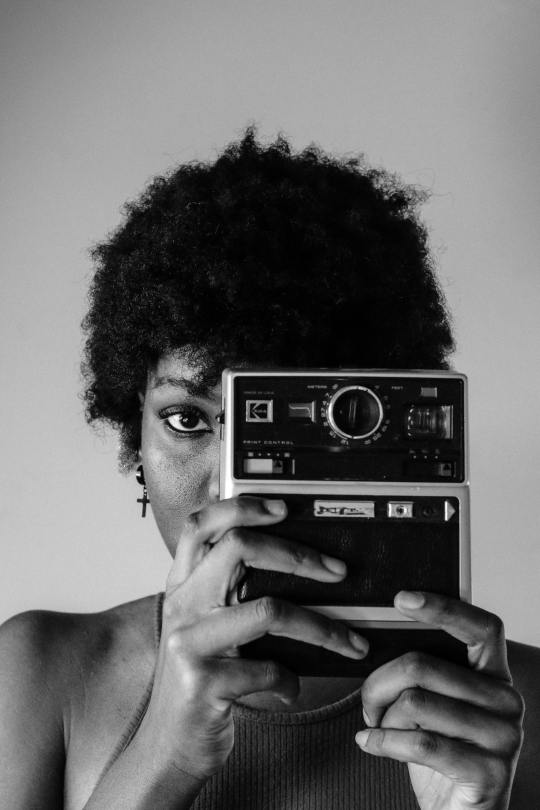
Soho House | DADDY Magazine x The Lovie Awards present: Visual Storytelling in BIPOC Communities
Which challenges do BIPOC filmmakers face when it comes to on-screen representation? What does visual storytelling look like in a predominantly white industry? Mona Okulla Obua and Emmanuel Amoako-Jansen a.k.a. Pennedhaus are Black filmmakers who shared their experiences within the industry. Welcome drinks were sponsored by our media partners The Lovie Awards.
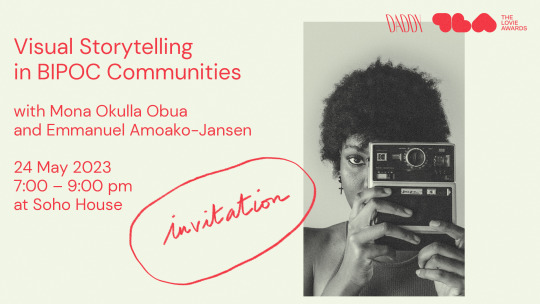
0 notes
Photo
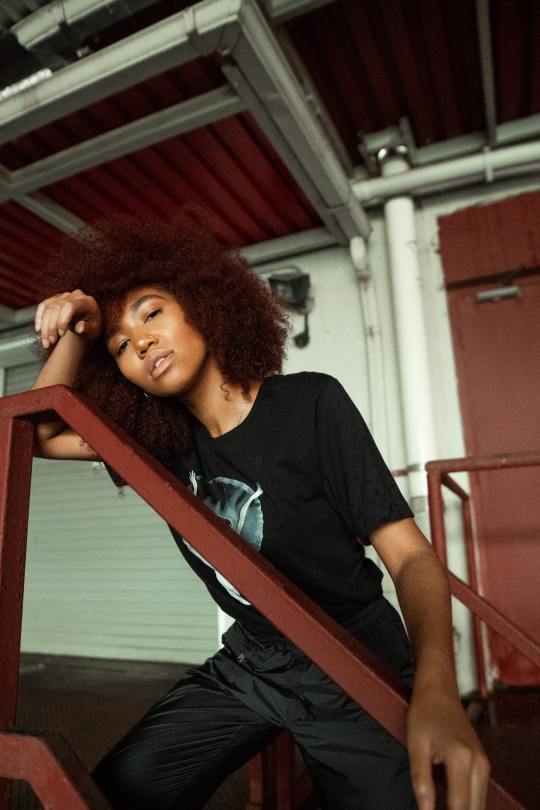
Soho House | DADDY Magazine presents: Community building with Refuge Worldwide and ROOTS Berlin
How has the pandemic affected underrepresented communities and what are the challenges faced by community-focused platforms? What does BIPOC advocacy look like in a city like Berlin, and in Europe? In mId-March 2023, Richard Akingbehin, co-founder of Refuge Worldwide and Naima Nazir, co-founder of ROOTS Berlin talked about the mission of their community-focused radio station and organisation.
0 notes
Text
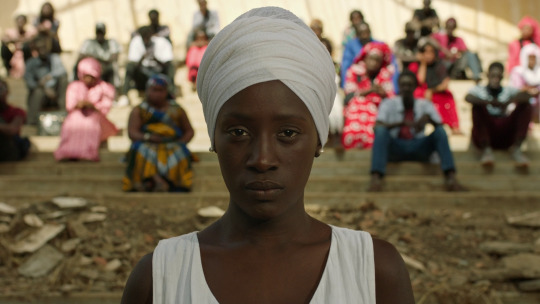
The Future is Africa | A female perspective: Portrayal of the Feminine in African and Diaspora cinema
The panel discussion casts a critical look on the role of women in African and Diaspora film – both in terms of female directors working in the industry, as well as the representation of women in film.
The panel discussion casts a critical look on the role of women in African and Diaspora film – both in terms of female directors working in the industry, as well as the representation of women in film.
With Moussa Séne Absa, Sandulela Asanda and Laurentine Marie Bayala. Presented by Kemi Fatoba.


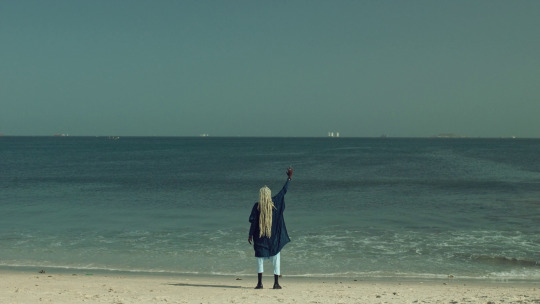
Photos © Xalé; Moussa Séne Absa
View original
1 note
·
View note
Video
youtube
Soho House | DADDY Magazine presents: Publishing for us, by us
In mid-February, we hosted “Publishing for us, by us,” our first event of the year, at Soho House Berlin. Kemi Fatoba, our founder, interviewed Linda Nübling, founder of Gurlz with Curlz and Scott Kränzlein, former managing director and now board member of Nataal, about the realities and challenges faced by BIPOC publishers within a very white and elitist publishing industry.
Our guest speakers were able to engage with a very curious and intrigued audience in regards to the do’s and don’ts within the industry. They provided insights on the differences and the similarities between the UK, US and German publishing industries and also discussed the financial gap between white and Black publishers when it comes to creating print magazines.
Browse a selection of photos from the panel discussion below and watch the full panel discussion here. Make sure to stay tuned for the next DADDY event.
Want more DADDY? Sign up to our newsletter for new stories, upcoming events, and more!
0 notes
Photo

DADDY Magazine | Contemporary And – a Global Art Network for Africa and the Diaspora
Kemi Fatoba sat down with Julia Grosse and Yvette Mutumba to talk about their platform-turned-cosmos.
Why did you decide to launch Contemporary And?
Yvette: In 2012, the ifa (Institute for Foreign Relations) - chiefly the former head of their visual arts department, Elke aus dem Moore - suggested setting up a platform for contemporary art from Africa. They asked Julia to come on board, and we took it from there, developing C& into what it is today.
Julia: At the time, other important magazines such as Nka from the US or Revue Noire from France had already paved the way in terms of focusing on artistic production from Africa and the diaspora. A digital platform, bringing together these enormously rich and complex perspectives in a non-academic and more broadly accessible way, did not yet exist. This was the idea and the reason behind launching C&.
C& started as an online platform but evolved into so much more. Can you give us an overview of what you are doing besides the online and print magazines?
Yvette: Yes – since its launch C& has expanded into various digital and analogue projects, which are all closely related to the content and idea of the magazine. Since 2016, we have facilitated critical writing workshops, mentoring programmes, and a number of other initiatives aimed at young art writers.
At the moment, there's a newfound interest in art and culture from the continent. Do you think it will have a lasting effect?
Julia: The so-called hype around visual art from African perspectives is something we had already experienced when we launched C& almost ten years ago. It was always clear to us that hype comes and goes, and that should never affect our vision. One of our visions is that, at some point, artists with an African perspective won’t get invited to group shows to make programmes more "diverse", but because the curator is genuinely interested in their artistic approach and practice.
What does it feel like to be a part of this shift?
Yvette: It feels like C& has contributed to this shift. Initially, people called us a “niche” project for “experts on Africa”. That’s no longer the case, and it's also reflected in our growing, broad readership. Through this shift, we have gained a different kind of confidence: Given that we literally cover the artistic production of an entire continent and its global diaspora, how could we ever have been considered niche? Despite the increased interest in art from the continent, so far, no other visual arts magazine is capable of matching what we're doing.
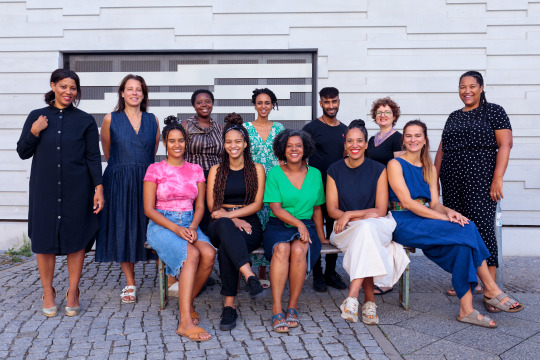
How do you navigate stereotypes about art from the Global South and the fascination with Black pain?
Yvette: C& is building an archive of parallel narratives, which centres on Black artistic production. It’s a space where artists and writers reflect on issues and debates that are relevant to them. Sometimes, this content purposefully takes on such stereotypes. More often, though, the broadness of artistic voices in Africa and the global diaspora goes far beyond stereotypes. So for us, it's about pointing out stereotypes without reiterating them.
In our current issue, we explore how underrepresented communities explore and experience joy while the world is seemingly going up in flames. Is there space for Black joy in the art world?
Julia: That's a big one… but obviously, we would say yes! There are many beautiful, meaningful networks for artists and art producers around the globe. It’s also fantastic to see global art events, such as the Biennale de Dakar, the São Paulo Art Biennial or the Yango Biennial of Kinshasa, becoming real places of encounter again.
Yvette: Oh yes, of course there is space for Black joy! Enjoying the company and work of Black cultural producers and empowering each other is key.


What are the things that bring you joy – professionally and personally?
Yvette: Professionally, it’s always a great joy to follow the development of young art writers and artists. As C&'s primary focus is on presenting artists that aren’t super established yet, it's fantastic to see people succeed in various ways. Another thing is getting feedback from C& readers – when they have a fan moment or comment on something we have published. These interactions are great, as we rarely meet the people who access our online platform. Personally though, the main things that bring me joy are my kids, my partner, our families, great friends, and good conversations.
Julia: Yvette mentioned all the essential things already. Spending time in nature also brings me joy and energy.
What's next?
Julia: Right now, we are involved in a big publishing project with four collectives from documenta 15. We'll publish our next print issue later this year, and we are also heavily brainstorming for our 10th anniversary in March 2023.
About C&
As a predominantly digital project, C& and C& América Latina have a substantial global network and physical offices in Berlin and Nairobi.
C& Workshops provide the tools for writing art reviews, comments, and essays. They have taken place in cities like Lagos, Nairobi, Lubumbashi, Luanda, Harare, and Detroit.
C& Mentoring Program is a six-month mentorship program connecting students with senior arts writers. The mentees receive a small stipend and the possibility of publishing selected texts in the online editorial sections of C& Magazine and C&AL Magazine. The C& Mentoring Program has connected mentors and mentees from Colombia, Egypt, Ghana, Morocco, Ethiopia, Kenya, the Democratic Republic of Congo, Angola, and Brazil.
C& Commissions is aimed at artists who create digital works or exhibitions, which will be showcased at C&.
C& Artists’ Editions is a program for specially commissioned editions from artists who are part of the C& network. The editions offer an accessible, collectable portfolio of works from new and established artists.
C& Center of Unfinished Business is a reading room, offering visitors an extraordinary and sometimes disconcerting selection of books linked to colonialism in various ways – from German colonies to Congolese fashion and capital markets of the twenty-first century. Since 2017, the Center has been travelling and connecting with various cultural institutions in Europe and the US.
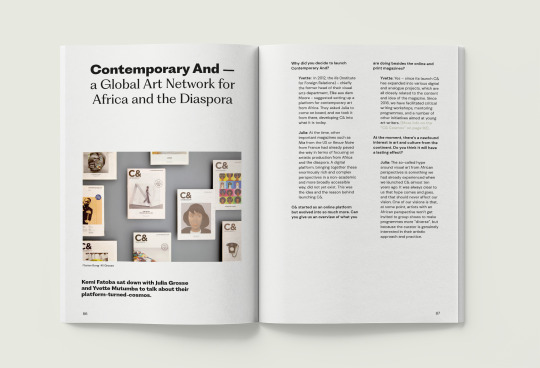
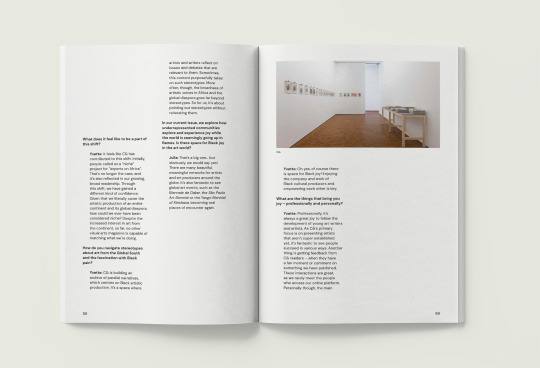

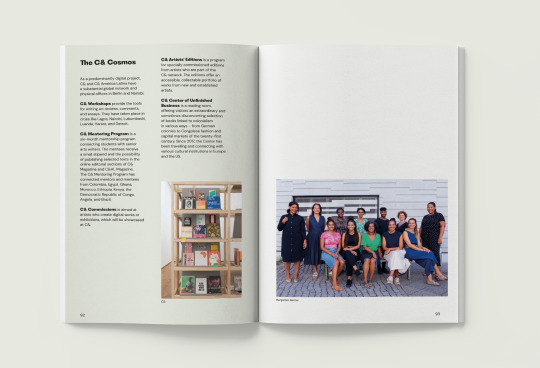
View original
0 notes
Photo
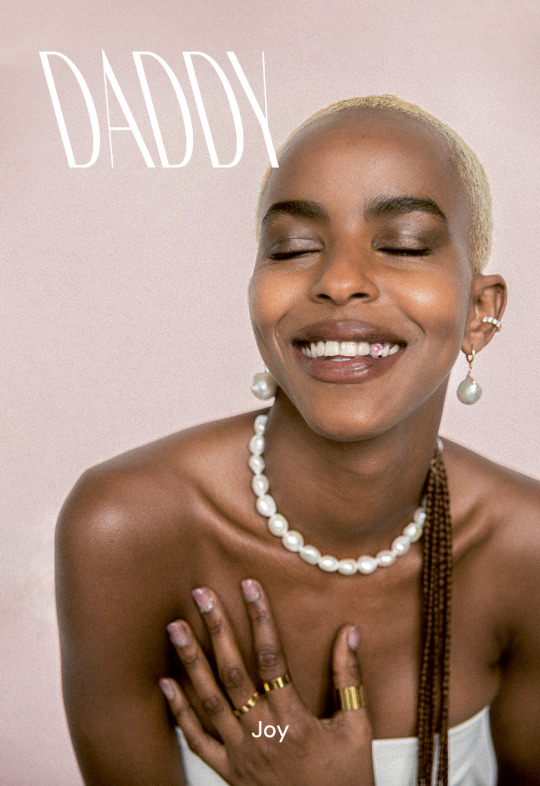
DADDY Magazine | The JOY Issue
The JOY issue is dedicated to the small and big things that bring us happiness – despite everything that's going on in the world right now.
Read about the Black nod, unapologetic queer love, the importance of Black joy and feast your eyes on photographs and artworks that celebrate friendship, love, and intimacy.
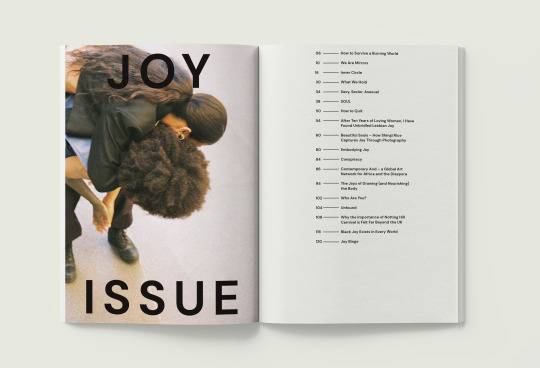
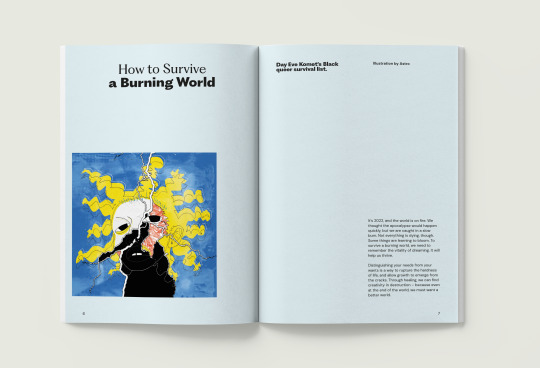
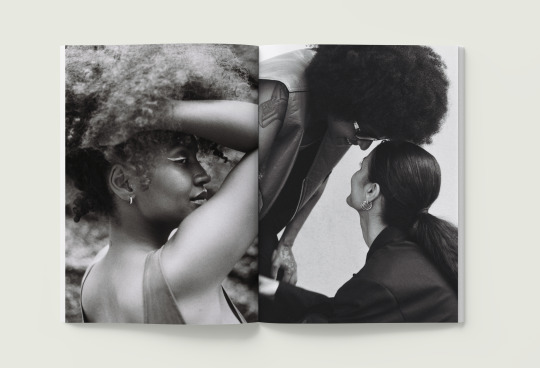
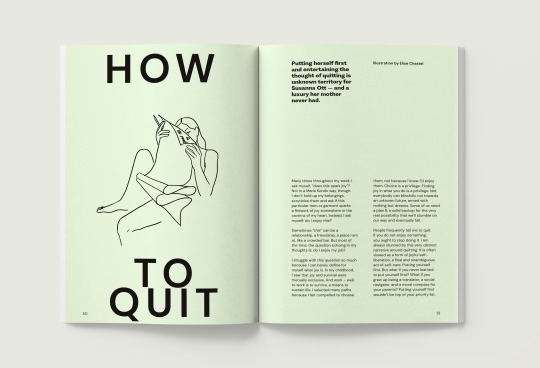

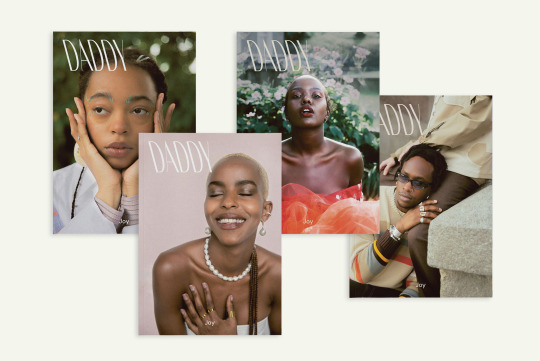
0 notes
Video
tumblr
ARD Kultur | Beyond Fashion: Visibility x Warum ist Fashion so weiß?
In Beyond Fashion trifft Hostin Avi Jakobs Menschen, für die Mode ein Lebensgefühl und ein Weg ist, ihre Identität auszudrücken. Gemeinsam mit ihrer Community finden sie Antworten auf Fragen, die uns alle etwas angehen.
Warum ist die Fashionwelt immer noch so weiß und wie werden rassistische Strukturen überwunden? Das erfährt Hostin Avi Jakobs von Mumi Haiati, Kemi Fatoba, Model Nicole Atieno, Designer Amesh und vom MADWOMEN Collective.

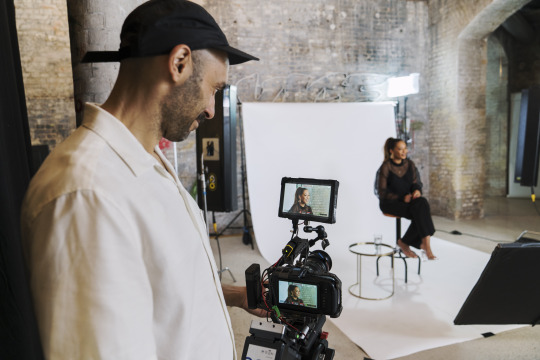
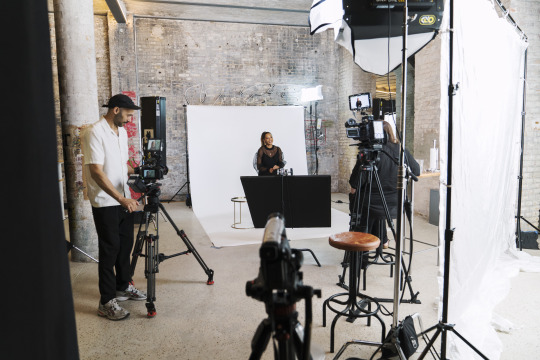
Photos: Weiya Yeung/ARD Kultur
View original
0 notes
Photo

VOGUE Beauty Special | Treatments für dunkle Hauttypen: Laser-Haarentfernung für jeden Hauttyp
Im dritten Teil unseres Beauty Specials über Treatments für dunkle Hauttypen erklären wir, welche neuen Methoden es zur Laser-Haarentfernung für jeden Hauttyp gibt.
Laser-Haarentfernung für jeden Hauttyp? Das sollten Sie beachten
Wenn es um Beautytreatments geht, wird Menschen mit melaninreicher Haut oft geraten, besonders vorsichtig zu sein, da das Ergebnis unberechenbar ist. Dabei gibt es mittlerweile viele neue Behandlungsmöglichkeiten für Pigmentstörungen wie Hyperpigmentierung, Laser-Haarentfernung und die Behandlung von Hautveränderungen wie z.B. Dermatosis papulosa nigra.
Gemeinsam mit der Dermatologin Dr. Ephsona Shencoru, die "The Questionnaire" betreibt, erklären wir in Teil 3 dieser Serie, welche neuen Laser-Haarentfernungsmethoden es gibt und warum nicht nur der Hauttyp, sondern auch der Haartyp dabei eine Rolle spielt – um die richtige Laser-Haarentfernung für jeden Hauttyp zu finden.
"Für eine lange Zeit waren die idealen Kandidat:innen für Laser-Haarentfernung Menschen mit heller Haut und dunklen Haaren, weil die Laser zur Haarentfernung auf diese Kombination am besten reagiert haben" – Dr. Ephsona Shencoru
Welche Laser eignen sich für welche Hauttypen?
Bei der Laser-Haarentfernung "konkurriert" das Pigment der Haut mit dem in der Haarwurzel, wodurch es durch inkorrekte oder falsche Anwendung zu Hypo-, Hyperpigmentierung oder Narbenbildung kommen kann. Menschen mit hellen Haaren und heller Haut, sowie Menschen mit dunklen Haaren und dunkler Haut sollten daher Alternativen zu IPL in Betracht ziehen.
"Es ist keine Behandlung, bei der man sparen sollte. Hier ist es besonders wichtig, Expert:innen aufzusuchen, ein Aufklärungsgespräch zu führen und einen Hauttest zu machen, denn Pigmentierungsstörungen als Ausdruck einer Verbrennung ersten Grades, sind bei melaninreicher Haut manchmal auch erst 30-60 Minuten nach der Behandlung sichtbar." – Dr. Ephsona Shencoru
IPL
"Intense Pulsed Light" ist kein richtiger Laser, sondern eine Blitzlichtlampe. Das Treatment ist technologisch schon so fortgeschritten, dass es zunehmend auch für dunkle Hauttypen verwendet wird. IPL-Geräte für den Hausgebrauch sind für melaninreiche Haut nicht empfehlenswert.
Nd:YAG-Laser
Dieser Laser ist für dunkle Haut besonders gut geeignet, da er tiefere Hautschichten erreicht und weniger Schäden an der Epidermis (der oberstenHautschicht) anrichten kann. Die Sicherheit des Lasers ist aber immer von den Anwender:innen abhängig. Die Haut muss während der Behandlung gekühlt werden.
SHR-Methode
Das "Super Hair Removal" funktioniert besonders gut bei heller Haut und hellen Haaren. Die Methode ist hautschonend und schmerzfrei, da die Haare nicht wie bei der IPL-Methode mit einem starken Impuls, sondern mit mehreren kleinen Impulsen entfernt werden.
Selbsttest: IPL-Haarentfernung
Disclaimer: Laut Fitzpatrick-Skala entspricht mein Hautton Typ V (auf einer Skala von I bis VI) und meine Haut neigt zu Hyperpigmentierung und der Bildung von Keloiden. Vor jeder Behandlung sollte unbedingt ein Test gemacht werden, um individuelle Reaktionen auf Laser-Treatments abzuwarten.
Da mir Dermatolog:innen für eine lange Zeit von Laser-Treatments abgeraten haben, war ich skeptisch, als mir die IPL-Methode zur Haarentfernung vorgeschlagen wurde und wartete den Test ab, bis ich mit der Behandlung begann. Es ist besonders wichtig, den Test an jeder Stelle, die behandelt wird, zu wiederholen, da es sonst bei den Hauttypen V und VI zu Verbrennungen kommen kann. Während der Behandlung habe ich die Sonne gemieden und hatte keine anderen Laser-Treatments. Wichtig: Diese Behandlung sollte nicht auf gebräunter Haut durchgeführt werden, da die Geräteeinstellung beim Verblassen der Haut nicht mehr stimmen könnte.
Fazit: IPL hat bei mir gut funktioniert, da der Kontrast zwischen meinem Hautton und meinen Haaren groß genug war. Es dauerte jedoch eine Weile, bis ich ein Ergebnis sah, da Haare zyklisch wachsen. Nach vier Behandlungen waren die Haare so gut wie verschwunden, was aber nicht bedeutet, dass sie nie wieder zurückkommen. Je nach Areal kostet eine Behandlung ab 39 Euro, z.B. bei My Perfect Face in Berlin. Obwohl viele Kosmetikstudios keine Tests anbieten, würde ich bei melaninreicher Haut immer darauf bestehen – bei jedem Areal.
Hier gehts zu Teil 1.
Hier gehts zu Teil 2.
View original
0 notes
Photo

VOGUE Beauty Special | Treatments für dunkle Hauttypen: Laser-Treatments bei Pigmentstörungen
Der zweite Teil unseres Beauty Specials zu Treatments für dunkle Hauttypen befasst sich damit, wie man Pigmentflecken lasern kann.
Pigmentflecken lasern bei dunklen Hauttypen? So können sie behandelt werden
Wenn es um Beautytreatments geht, wird Menschen mit melaninreicher Haut oft geraten, besonders vorsichtig zu sein, da das Ergebnis unberechenbar ist oder es an Erfahrung mangelt. Dabei gibt es mittlerweile viele neue Behandlungsmöglichkeiten für Pigmentstörungen wie Hyperpigmentierung, Laser-Haarentfernung und die Behandlung von Hautveränderungen wie z.B. Dermatosis papulosa nigra.
Gemeinsam mit den Dermatologinnen Dr. Ephsona Shencoru und Dr. Erika Hernekamp von HY STUDIO erklären wir in Teil 2 dieser Serie, wie Pigmentstörungen bei melaninreicher Haut behandelt werden können.
"Post-inflammatorische Hyperpigmentierungen zählen zu den Hauptgründen, warum Schwarze Menschen Dermatolog:innen aufsuchen. Um diese zu behandeln, sollte man jedoch immer zuerst der Ursache auf den Grund gehen – und immer Sonnenschutz verwenden." – Dr. Ephsona Shencoru
Wie äußern sich Pigmentstörungen bei dunklen Hauttypen?
Pigmentstörungen betreffen alle Hauttypen, sind aber bei dunkler Haut besonders häufig. Vereinfacht unterscheidet man zwischen Hyper- und Hypopigmentierung. Während die Behandlung von Hypopigmentierungen (z.B. Vitiligo) noch eine besondere Herausforderung darstellt, gibt es für Hyperpigmentierungen eine Reihe von Behandlungsmöglichkeiten.
Non-invasive und minimalinvasive Methoden
Facials: In Kombination mit einem guten Sonnenschutz sind regelmäßige Facials die beste Methode, um Pigmentstörungen vorzubeugen bzw. ein unebenes Hautbild zu verbessern. \
Azelainsäure, Retinol und andere Retinoide: Leichte Pigmentstörungen können mit diesen Wirkstoffen gut behandelt werden und eignen sich ebenfalls für alle Hauttypen. Retinoide haben außerdem den Vorteil, dass sie die Kollagenproduktion fördern und somit auch einen Anti-Aging Effekt haben.\
Hydrochinon: Der Wirkstoff ist EU-weit im Handel verboten, da viele Hydrochinon-Produkte Quecksilber enthalten und dauerhafte Hautschäden hervorrufen können. Als verschreibungspflichtiges Präparat, z.B. Pigmanorm Crème, das in korrekter Dosierung und unter ärztlicher Aufsicht angewendet wird, kann Hydrochinon Pigmentstörungen gut behandeln – nach ein paar Wochen sollte jedoch immer eine Pause eingelegt werden, um der Haut nicht zu schaden.
Microneedling: Bei tieferer Hyperpigmentierung, die z.B. durch starke Akne hervorgerufen wird, dauert es sehr lange, bis sie wieder verschwindet. Um diese zu behandeln, ist Microneedling eine gute Methode, da Cremes tiefe Hautschichten nicht erreichen.
Selbsttest: Laserbehandlung für Hyperpigmentierung
Disclaimer: Laut Fitzpatrick-Skala entspricht mein Hautton Typ V (auf einer Skala von I bis VI) und meine Haut neigt zu Hyperpigmentierung und der Bildung von Keloiden. Vor jeder Behandlung sollte unbedingt ein Test gemacht werden, um individuelle Reaktionen auf Laser-Treatments abzuwarten.
"Die Einstellungen des Lasers müssen sorgfältig und individuell angepasst ausgewählt werden, um Hautschädigungen zu vermeiden. Treatments, die die Haut irritieren könnten, sollten außerdem für den Behandlungszeitraum möglichst unterbrochen werden. Zudem ist ein konsequenter Sonnenschutz sehr wichtig, sowie auch das Meiden von lichtsensibilisierenden Präparaten wie beispielsweise Johanniskraut." – Dr. Erika Hernekamp; HY STUDIO, Berlin
Ein Kratzer, Mückenstich oder Pickel genügt, um eine bleibende Verfärbung auf meiner Haut zu hinterlassen, die monatelang anhält. Während kleine Flecken nach 2-3 Monaten verschwinden, kann es bei größeren Flecken ein Jahr oder auch länger dauern, bis sie vollständig verschwunden sind. Da das Risiko von Hypo- und Hyperpigmentierungen bei melaninreicher Haut besonders groß ist, wurde mir lange von Laserbehandlungen abgeraten. Die neue Generation von Lasern zum Pigmentflecken lasern eignet sich für alle Hauttypen, sollte aber nur von erfahrenen Personen durchgeführt werden.
Meine Behandlung wurde mit IPL, also "Intense Pulsed Light", durchgeführt. Ich hatte drei Sitzungen, die alle gleich verliefen: die Flecken verfärbten sich direkt nach dem Treatment und wurden dunkler. Danach hellten sie auf und es dauerte jeweils einen Monat, bis ich das Ergebnis sah.
"Bei Hyperpigmentierungen nach Entzündung oder Verletzungen sind etwa 3-5 Sitzungen nötig, um Resultate zu sehen. Nach den Treatments sollte direkte Sonneneinstrahlung aufgrund der Gefahr von erneuter Hyperpigmentierung vermieden werden. Die sonnenärmeren Monate sind daher die beste Zeit für Treatments dieser Art." – Dr. Erika Hernekamp; HY STUDIO, Berlin
Fazit: Nach der dritten Sitzung hatte sich mein Hautbild deutlich verbessert und die Hyperpigmentierungen waren kaum noch zu sehen. Kleinere Flecken sind komplett verschwunden und Flecken, die 1 cm oder größer waren, waren deutlich verblasst. Der Preis für eine Behandlung liegt bei etwa 250 Euro und lohnt sich besonders bei großflächigen Pigmentstörungen, die ansonsten wesentlich länger sichtbar wären. Die Behandlung erfordert viel Feingefühl und Geduld und sollte nur von Profis durchgeführt werden.
Hier gehts zu Teil 1.
View original
0 notes
Photo
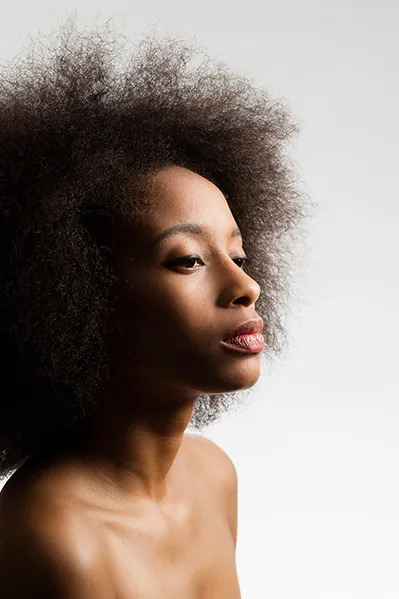
VOGUE Beauty Special | Treatments für dunkle Hauttypen: Behandlung von Dermatosis Papulosa Nigra
Im ersten Teil unseres Beauty Specials zum Thema Treatments für dunkle Hauttypen sprechen wir mit einer Expertin über die Behandlung von Dermatosis Papulosa Nigra.
Treatments für dunkle Hauttypen – was ist eigentlich DPN und wie kann es behandelt werden?
Wenn es um Beautytreatments geht, wird Menschen mit melaninreicher Haut oft geraten, besonders vorsichtig zu sein, da das Ergebnis unberechenbar sei. Dabei gibt es mittlerweile viele Treatments für dunkle Hauttypen und neue Behandlungsmöglichkeiten für Pigmentstörungen wie Hyperpigmentierung, Laser-Haarentfernung und die Behandlung von Hautveränderungen wie z.B. Dermatosis papulosa nigra.
Gemeinsam mit der Dermatologin Dr. Ephsona Shencoru erklären wir in Teil 1 dieser Serie, wie Dermatosis papulosa nigra (DPN), eine Hautveränderung, die vor allem Menschen mit dunklen Hauttypen betrifft, behandelt werden kann. Dr. Shencoru betreibt den Blog "The Questionnaire" und versucht darin Fragen zu beantworten, die ihr von Schwarzen Menschen und People of Colour immer wieder gestellt werden. Als Schwarze Frau hat sie selbst erlebt, welche Spuren Behandlungen, die nicht auf melaninreiche Haut abgestimmt sind, auf dem Körper hinterlassen können.
"In der Medizin ist der "Normalpatient" weiß und männlich. Die Behandlung von Schwarzen Patient:innen war in meinem Studium nur dann ein Thema, wenn es um außergewöhnliche Infektionskrankheiten ging." – Dr. Ephsona Shencoru
Was ist Dermatosis papulosa nigra (DPN)?
Unter DPN versteht man muttermalähnliche kleine Knötchen, die im Laufe der Zeit vor allem im Gesicht, am Hals und im Dekolleté entstehen und oft mit Fibromen verwechselt werden. Bekannte Persönlichkeiten wie Morgan Freeman, Beyoncé, Gabrielle Union und Tracee Ellis Ross haben DPN und obwohl die Knötchen harmlos sind, werden sie oft als störend oder unästhetisch empfunden.
"DPN erreicht eine Größe von 1-5 mm und betrifft Menschen mit dem Hauttyp III bis VI auf der Fitzpatrick-Skala bzw. ethnische Gruppen, deren Ursprung in Südostasien oder Afrika ist. Die genaue Ursache für das Entstehen der Knötchen ist nicht bekannt, es wird jedoch vermutet, dass Veranlagung, Alter und Sonneneinstrahlung beitragende Faktoren sind. Man geht mittlerweile davon aus, dass es sich bei der DPN um eine Variante der uns bekannten seborrhoischen Keratose (ein gutartiger Hauttumor) handelt." – Dr. Ephsona Shencoru
Trotz der Ähnlichkeit zu Fibromen sollte DPN keinesfalls auf die gleiche Art und Weise behandelt werden, da die Entfernung der Knötchen zu Hyperpigmentierungen führen kann. Darunter versteht man Verfärbungen der Haut, die durch Kratzer, Pickel und andere Arten von Entzündung oder Trauma hervorgerufen werden können. Bei Menschen mit melaninreicher Haut fällt Hyperpigmentierung besonders auf, da die Stellen für eine lange Zeit dunkel bleiben und ohne Behandlung erst nach Monaten verschwinden. Während kleine Flecken schon nach wenigen Monaten verblassen, kann es bei starker Hyperpigmentierung Jahre dauern, bis sie verschwunden ist. Man kann durch Facials und Cremes mit bestimmten Inhaltsstoffen nachhelfen – mittlerweile gibt es aber auch Laser, die den Heilungsprozess beschleunigen.
Selbsttest: Treatments für Dermatosis papulosa nigra
Disclaimer: Laut Fitzpatrick-Skala entspricht mein Hautton Typ V (auf einer Skala von I bis VI) und meine Haut neigt zu Hyperpigmentierung und der Bildung von Keloiden. Vor jeder Behandlung sollte unbedingt ein Test gemacht werden, um individuelle Reaktionen auf Lasertreatments abzuwarten.
An mir selbst habe ich DPN zum ersten Mal mit Mitte 20 bemerkt und verschiedene Treatments ausprobiert – mal mit mehr, mal mit weniger Erfolg. Da die Entfernung eine private dermatologische Behandlung ist, sollte man mit Kosten von ungefähr 150 Euro (pro Bereich) rechnen.
1. CO2-Laser. In Deutschland ist der CO2-Laser für kosmetische Hautbehandlungen häufig die erste Wahl. Er wird zur Behandlung von Fibromen und anderen Veränderungen der Hautoberfläche empfohlen, da er als präzise und effektiv gilt.
Fazit: Die Behandlung ist nichts für Haut, die zu Hyperpigmentierung neigt. Bei diesem Laser ist es besonders wichtig, einen Test zu machen, da Verfärbungen erst nach mehreren Stunden auftreten können, möglicherweise wesentlich größer als das behandelte Areal ausfallen und in meinem Fall erst nach 6-8 Monaten wieder verheilt waren.
2. Manuelle Entfernung. Bei dieser Behandlungsmethode werden die Knötchen manuell mit einem Skalpell entfernt. Sie gilt als schonend und wird deshalb bei allen Hauttypen angewendet.
Fazit: Auch diese Methode kann ich bei Haut, die zu Hyperpigmentierung neigt, nicht empfehlen, da ebenfalls großflächige Verfärbungen entstehen können – insbesondere dann, wenn Dermatolog:innen nicht extrem vorsichtig vorgehen.
3. Kaustik/Kauterisation/Elektrokauter. Das störende Gewebe wird hier mit kurzen, intensiven Stromstößen punktgenau behandelt. Nach der Behandlung bildet sich eine Kruste in der Größe der Knötchen.
Fazit: Perfekt für meinen Hauttyp geeignet, weil nur minimale Hyperpigmentierung entsteht, die mit einem Kratzer oder Mückenstich vergleichbar ist. Auch bei dieser Behandlungsmethode besteht ein Risiko für Pigmentveränderungen oder Narbenbildung.
View original
0 notes
Photo

VOGUE | Naomi Campbell auf dem Cover der deutschen VOGUE
Unser Cover-Model müssen wir Ihnen nicht vorstellen. Eigentlich. Naomi Campbell ist eine Ikone und ein fester Bestandteil unseres kollektiven popkulturellen Gedächtnisses. Seit 37 Jahren ist sie im Geschäft, erschien auf über 500 Magazincovern und ist das einzige Supermodel der Neunziger, das noch regelmäßig auf Laufstegen und in Kampagnen zu sehen ist. In einer Branche, die nicht nur für ihre Schnelllebigkeit, sondern auch für ihren Jugendkult bekannt ist, hat sie nichts an ihrer Relevanz eingebüßt – im Gegenteil, sie zählt im Alter von 52 Jahren immer noch zu den gefragtesten Models der Welt. Dennoch gibt es einige lose Enden, die viel zu selten auserzählt werden.
Naomi Campbell ist eine Vorreiterin, hat vielen Models, die nach ihr kamen, den Weg geebnet und erlebt auch jetzt, nach all den Jahren, immer noch Premieren. Sie gilt als eine der schönsten Frauen der Welt, wurde aber erst 2018, im Alter von 48 Jahren, von NARS für ihre erste Beautykampagne gebucht. Der Höhepunkt ihrer Karriere ist aber definitiv ihre Tochter, um die sich jetzt alles in ihrem Leben dreht. Als sie letztes Jahr zum ersten Mal Mutter wurde, beschrieb sie es als „das Beste, das ich jemals in meinem Leben gemacht habe“.
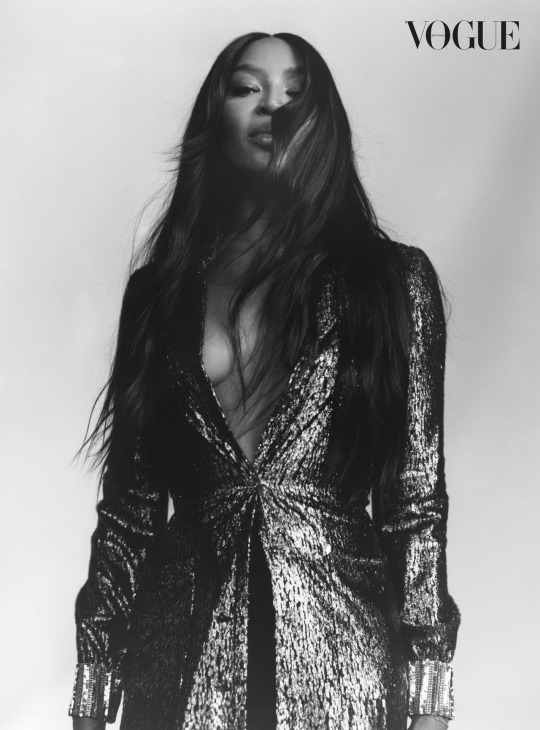
Man kommt natürlich trotzdem nicht umhin, all die glanzvollen Meilensteine der Londonerin aufzuzählen. Um das Prinzip Campbell zu verstehen, muss der Rahmen abgesteckt werden. Er besteht so gut wie ausschließlich aus Superlativen und einem komplizierten Geflecht aus Nahbarkeit und Distanz. Ihre Modelkarriere begann mit 15 Jahren, nachdem sie beim Shoppen in Covent Garden gescoutet wurde. Sie lebte damals mit ihrer Mutter, Valerie Morris-Campbell, im südlichen Stadtteil Streatham und lernte an der Italia Conti Academy of Theatre Arts, da sie, so wie ihre Mutter, Tänzerin werden wollte. Mit acht Jahren hatte sie ihren ersten öffentlichen Auftritt im Musikvideo zu Bob Marleys „Is This Love“, mit zwölf Jahren tanzte sie in Culture Clubs „I’ll Tumble 4 Ya“, und nach ihrer Entdeckung dauerte es nicht lange, bis sie auf dem ersten Cover zu sehen war: dem der britischen ELLE. Sie war als erste Schwarze Britin seit 1966 auf der VOGUE UK (Dezember 1987) und das erste Schwarze Model auf dem Cover von VOGUE France (1988) und VOGUE Russia (2000). Viele weitere Cover, zahlreiche Catwalks, Modekampagnen, Auftritte in TV-Serien wie „Die Bill Cosby Show“, „Der Prinz von Bel-Air“ und „Empire“ sowie in Musikvideos von Stars wie George Michael, Madonna, Michael Jackson, Aretha Franklin, Jay-Z, The Notorious B.I.G. und Beyoncé folgten. Naomi Campbell war Jurorin in der Model-Casting-Show „The Face“, hatte vor Kurzem einen Gastauftritt bei „RuPaul’s Drag Race“, und seit ein paar Jahren gibt das Model auf seinem Youtube-Kanal sehr private Einblicke in sein Leben.

Der Teil, der zwischen all diesen Superlativen und der stabilen Präsenz oft untergeht, ist dabei eigentlich der sehr viel wichtigere. Ikone hin oder her: Das oft verwendete Zitat, doppelt so viel arbeiten zu müssen, um halb so viel zu bekommen, galt auch für sie. Naomi Campbell sprach häufig darüber, dass sie weniger verdiente als ihre weißen Kolleginnen. Ihre Direktheit – aber auch ihr Umgang mit Kontroversen – hatte zur Folge, dass sie für eine lange Zeit in den Medien als Zicke dargestellt wurde. Sie dementierte immer wieder Gerüchte, nicht mit anderen Schwarzen Models arbeiten zu wollen. 2006 machte sie Schlagzeilen, weil sie ihre Haushälterin in einem Wutanfall mit einem Mobiltelefon bewarf und die Community-Arbeit, zu der sie verdonnert wurde, in High Heels und Designerkleidung verrichtete. Als sie 2010 in einem Prozess über Blutdiamanten in den Zeugenstand berufen wurde, bezeichnete sie das als eine „große Unannehmlichkeit“ und legte den Grundstein für zahlreiche Internet-Memes, die heute im Umlauf sind.

Naomi Campbell behauptete nie, perfekt zu sein. Im Gegenteil, sie bezeichnet sich selbst immer als ein „Work in Progress“, also als eine Person, die noch an sich arbeiten muss. Ihre Karriere begann lange vor Black Lives Matter und #MeToo, in einer Zeit, als Boulevardmedien maßgeblich die öffentliche Meinung prägten und behauptet wurde, dass sich Cover mit Schwarzen Models nicht verkaufen. Bei Superstars wie Beyoncé oder Rihanna wurden natürlich Ausnahmen gemacht. Das Stereotyp der „Angry Black Woman“, also der wütenden Schwarzen Frau, kam regelmäßig zum Einsatz, wenn über Naomi Campbell berichtet wurde, und führte dazu, dass sie kaum noch Interviews gab. Egal, was man von ihr halten mag, aus heutiger Sicht besteht kein Zweifel daran, dass die Art und Weise, wie über sie berichtet wurde, unfair und von rassistischen Vorurteilen geprägt war.
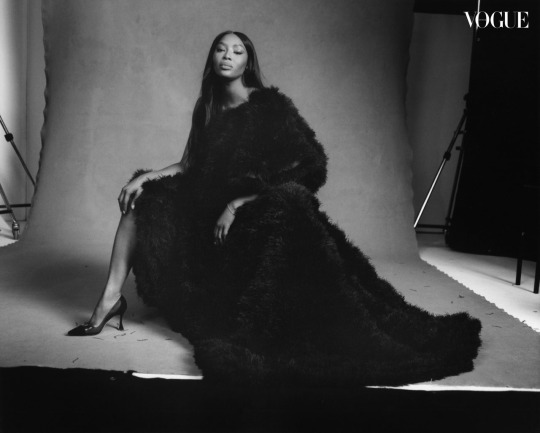
Im Unterschied zum Anfang ihrer Karriere erzählt Naomi Campbell heute ihre eigene Geschichte – auf Youtube und Instagram. Sie spricht offen über Tokenismus und Diskriminierung in der Modebranche und dass sie es ohne die Unterstützung ihres Umfelds wesentlich schwerer gehabt hätte. Das Umfeld waren die Models Iman und Katoucha Niane, die sich wie Schwestern um sie kümmerten, als Naomi Campbell auf der Bildfläche erschien; Designer wie Yves Saint Laurent, Gianni Versace und Azzedine Alaïa, die ihr zu Kampagnen und Covers verhalfen, und ihre Supermodel-Freundinnen Christy Turlington und Linda Evangelista, die sich weigerten, Jobs anzunehmen, wenn Naomi Campbell nicht auch gebucht wurde.
In einem Youtube-Interview mit Iman erzählt sie, wie normal es war, von Casting-Agent:innen Sätze wie „Wir wollen in dieser Saison keine Schwarzen Models sehen“ zu hören und dass Naomi Campbell oft selbst zum Telefon griff, um Designer:innen zu fragen, ob sie wussten, was da in ihrem Namen getan wurde. Sie tat dies nicht, um Probleme zu bereiten, sondern „um auf Probleme aufmerksam zu machen“, wie sie es im Gespräch mit Iman formulierte. Die beiden gingen auch auf den Druck ein, der Schwarzen Models von außen auferlegt wurde, da ihnen immer wieder gesagt wurde, dass es nur eine geben konnte. Anstatt einander als Konkurrentinnen zu sehen, brachte sie das jedoch nur näher zusammen. Vor allem zeigt Naomi Campbell online das, was ihr in all den Jahren von den internationalen Boulevardmedien abgesprochen wurde: ihre Komplexität.
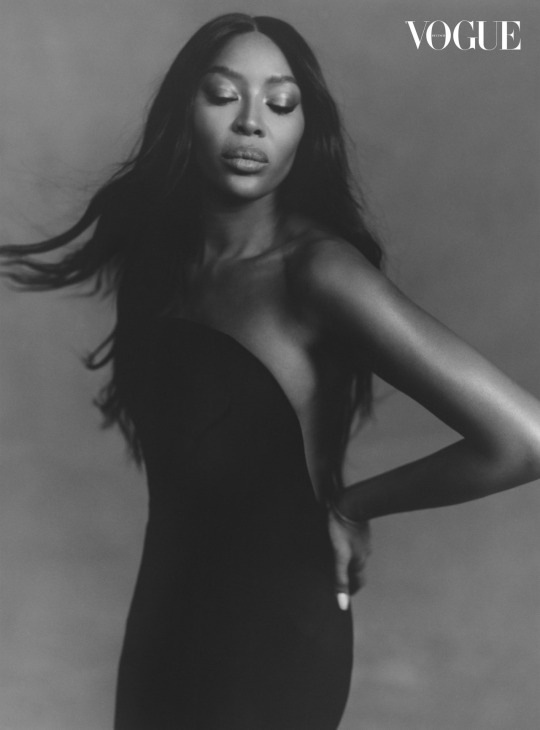
Den Status einer Ikone hat sie nicht nur wegen ihrer Karriere als Model – in ihren Videos sieht man ihre humorvolle, verletzliche, zurückhaltende und überschwängliche Seite. Naomi Campbell spricht in den höchsten Tönen von ihren Freund:innen, Mentor:innen und Wegbegleitenden und ist mittlerweile selbst zu einer Mentorin geworden – von Adut Akech, Anok Yai, Ugbad Abdi, Kaia Gerber und vielen anderen Models.
Sie unterstützt Designer:innen wie Tiffany Amber, Thebe Magugu und Kenneth Ize und bezeichnet es als ihre Mission, für mehr Diversität in der Modebranche und eine bessere Repräsentation des afrikanischen Kontinents zu sorgen. Sie setzt sich seit Jahrzehnten für die LGBTQI+-Community ein und gründete 1988 gemeinsam mit Iman und Bethann Hardison die „Black Girls Coalition“, um auf den großen Mangel an Models of Colour auf den weltweiten Laufstegen aufmerksam zu machen. Im Jahr 2005 gründete sie die Charity-Organisation „Fashion for Relief“, mit der sie Millionen von Dollar für die Opfer des Hurricane Katrina, der Ebola-Pandemie in Westafrika, des Erdbebens in Haiti und zuletzt für Covid-19 in Großbritannien sammelte.
Naomi Campbell ist sich selbst treu geblieben. In ihren Videos betont sie immer wieder, dass nichts von dem, was jetzt in den Medien geschieht, neu für sie sei. Sie spielt auf das Thema Diversität, auf das plötzliche Interesse am afrikanischen Kontinent und den Talenten, die von dort kommen, an. Sie schätzt, dass sie nun offen über diese Dinge sprechen kann, weiß aber gleichzeitig, dass ihre Arbeit noch nicht getan ist. In einem Interview über ihren vollen Terminkalender und die zahlreichen Projekte, in die sie involviert ist, zitierte sie den verstorbenen Nelson Mandela, der ein enger Freund und Mentor war und zu ihr sagte: „Wir werden schlafen, wenn wir nicht mehr da sind.“
View original
1 note
·
View note
Photo
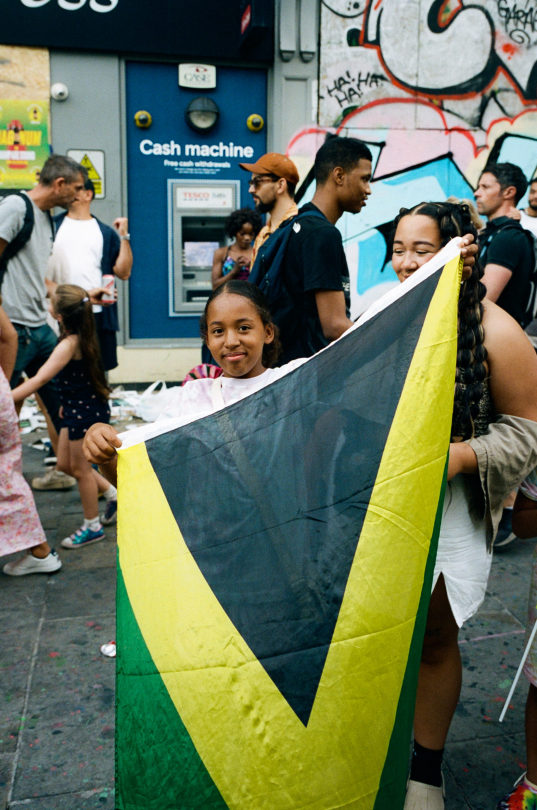
Document Journal | Notting Hill Carnival is a haven for Black joy in the UK
The famous Caribbean street party attracts visitors from all over, providing a weekend-long respite from the reality of being Black in Europe
“I hate Carnival. It gives men an excuse to behave badly,” said the waitress serving us drinks. It was Sunday evening, and the streets were full of people who had been celebrating slowly making their way home. After I told her that I flew in from Berlin for the occasion, she looked at me and my friend, smiled politely, and wished us lots of fun. She had a valid point: At Carnival, the social contract we all live by seems to be thrown out the window. Fully-grown men openly gawk at teenage girls and, seconds later, relieve themselves in the street; elbows fly carelessly in the crowd, and non-consensual wining can leave a bad taste in your mouth; the crowd dynamics that flip from cheerful to hostile within seconds can be overwhelming. But Carnival is also where we see Black joy, Black bodies in all shapes and forms, gorgeous Black hairstyles, carefree Black children, and Black love. And while it welcomes everyone, Carnival is unapologetically Black—and that’s exactly why I love it.
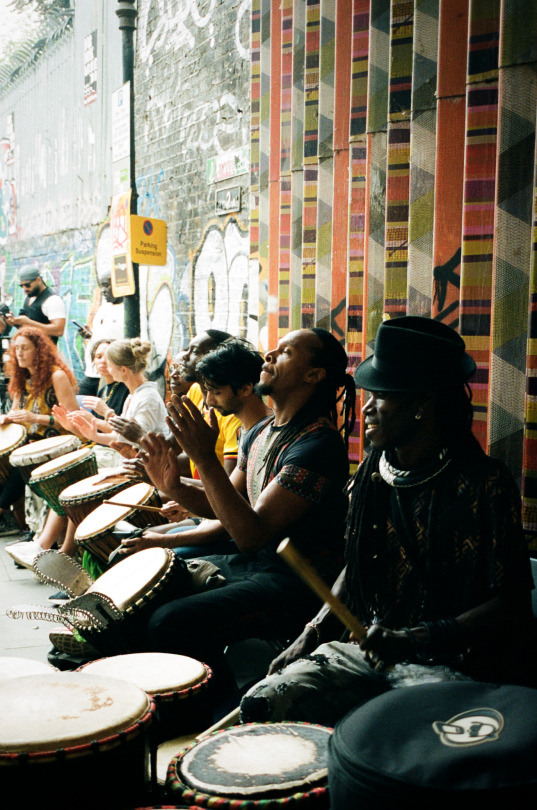

Until its forced two-year hiatus during the pandemic, Europe’s biggest street party attracted over two million visitors each year. Since 1966, people from all over the UK have traveled to Notting Hill to celebrate Black Caribbean culture during the last weekend of August. A lot has happened since 2019: We lived through lockdowns and mental health crises; Brexit “got done”; Black Lives Matter briefly became a trending topic globally; the war in Ukraine broke out; inflation ensued; and the cost of living crisis still looms. Collective moments of joy and escapism have become incredibly rare and precious, which made this year’s Carnival so special.
Carnival polarizes. To some, it represents everything that’s great about London: the blending of cultures, races, and nationalities. Others campaign for it to end, spinning a false narrative that equates Black communities with crime and violence—so far, without success. (But if we’ve learned one thing in the last two years, it’s to never take anything for granted.) There are, of course, also those who feel indifferent about Carnival, or prefer going to events that feel more inclusive, like Black Pride, which is celebrated in mid-August. For me—and other friends who also traveled to London from abroad—Carnival is not just a celebration of Caribbean culture, but also a much-needed respite from the exhausting reality of being Black in Europe.
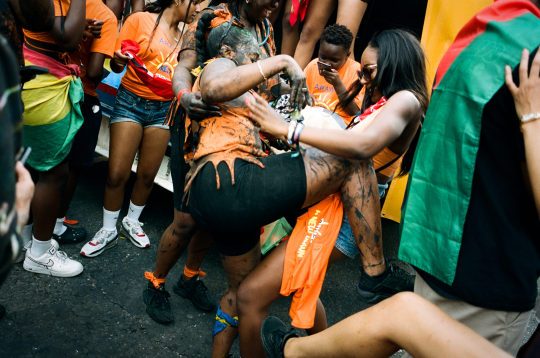
While some Brits are convinced that the UK is “bad vibes,” many Black and Brown Europeans argue that the vibe in their countries is far worse. Granted, our governments hate regular, working-class people less than the British one does, but when it comes to conversations about race and the treatment of our BIPOC communities, we are decades behind. Unlike the UK, other parts of Europe get away with the atrocities on the African continent under colonial rule, because they are overshadowed by other atrocities, such as World War I, World War II, and European fascist movements. As such, the European approach to dealing with its colonial past and the ongoing dehumanization of people of African descent is a mixture of amnesia, erasure, and an awkward dance around conversations about race. So awkward, in fact, that Black Europeans like myself feel the need to travel abroad to experience Black joy.
That’s also why the importance of Carnival is felt far beyond the UK’s borders. Being able to soak up the energy, dance, and get lost in a sea of people who look like you—and make you feel like you belong—is priceless. Having a good time without being told that we are too loud, too much, too Black is something I don’t take for granted. I also can’t help but appreciate the hustle during Carnival, which reached a new high when I was offered a quiet spot to sit down and eat my jerk chicken for the bargain price of £5.
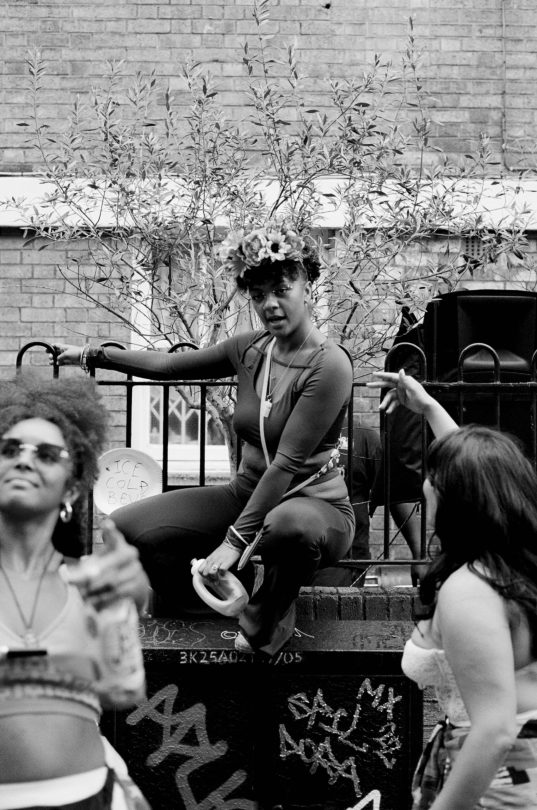
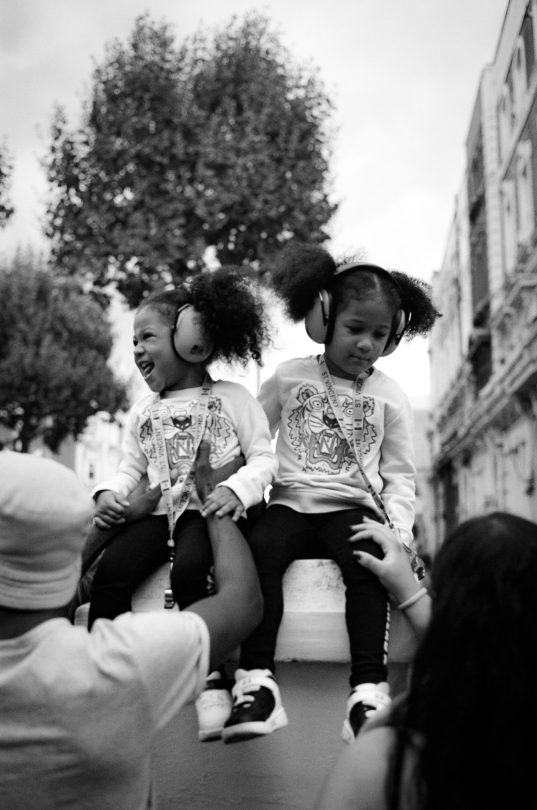
As day two came to an end, I stood at the corner of Westbourne Grove and Chepstow Road and watched the last truck turn around the corner. The sun fought its way through the clouds and hit the smiling faces of people of all races, ethnicities, cultures, and ages who danced alongside it. Some were off-duty dancers in sparkly, feathered costumes, others waved Caribbean flags, and everyone sang in unison when the DJ played Burna Boy’s “Last Last.” It was the perfect ending to a celebration we’ve all been waiting for, and it captured everything that’s great about Carnival—and, by extension, London.
View original
0 notes
Video
youtube
re:publica 2022: .txt – Writing against the machine
Das Schreiben ist Ausgangspunkt und Grundlage gesellschaftlichen Wandels. Vom Flugblatt bis zum Tweet wird die Verschriftlichung dafür genutzt, Menschen zu mobilisieren, Missstände zu formulieren und Wandel zu fordern.
Özge und Kemi sprechen über das revolutionäre Potential von Sprache in verschiedenen Medien. Wie schaffen wir über Sprache den Wandel, den wir brauchen, um eine bessere Gesellschaft zu erreichen? Wie werden in Sprache und Schrift Anknüpfungspunkte geschaffen, um Menschen zu verbinden?
View original
0 notes
Photo
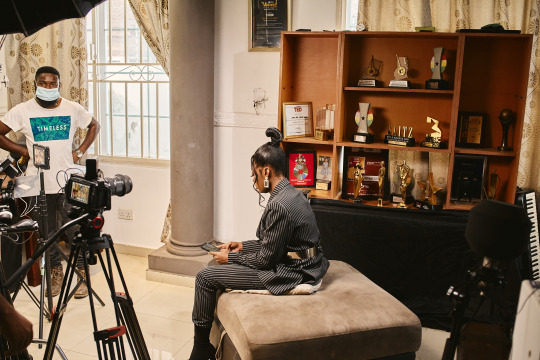
Soho House | DADDY Magazine presents: ADIKORO – Film Screening and Q&A
Whether its Wizkid or Burna Boy, sold-out tours or features with stars like Drake and Beyoncé: pop from the continent has entered the global stage and will stay there. While male Afrobeats artists are increasingly gaining attention globally, female acts have a harder time. In her debut film ADIKORO, which means "equal" in Twi, Afropop expert and curator Pamela Owusu-Brenyah explores why that's the case. The documentary was mainly shot in Ghana and looks at the socio-economic conditions that block women's access and visibility in the local and global music business while also encouraging female artists to follow their dreams of a music career.
0 notes